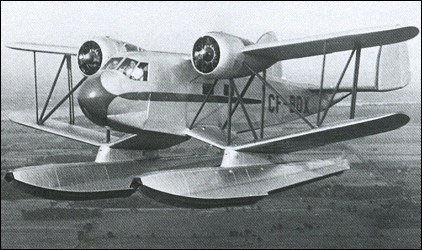|
| There is no text information for this aircraft at the moment.
| Doug, e-mail, 11.07.2016 00:41 Acquired the 30-day commercial scale arcade clock from the Great Lounge Rotunda lobby of the now defunct Bigwin Inn at Lake of Bays. An image of CF-BDX was applied to the clock face at some point and I am wondering if anyone might know why. Thanks. reply | | Phil Sattler, e-mail, 21.06.2012 05:42 Would like to locate some pictures of a Fleet 16B with a 5 cyl. Kinner engine reply | | northern expat, e-mail, 07.02.2012 18:10 need to add the Fleet-80 which was a tough little side by side trainer.Spent many happy hours learing and later instructing in this aircraft.It was a land in a field fun bird and should be in this Fleet album. reply |
| Leigh Murdoch, e-mail, 01.11.2011 06:56 In a book by Larry Milberry, 1985, titled "Austin Airways Canada's Olderst Airline" has a photograph of CF-BDX on page 53, described as the prototype Fleet Freighter. Austin Airways did operate a Fleet 50K Freighter, CF-BJW, from May 12, 1945 till Oct 6, 1946 when destroyed by fire. reply | |
| | John Fox, e-mail, 14.03.2011 01:07 From a book I have just read,"Wing Walkers,"the Fleet 50 in this photo has the same paint work as one operated by
Grant McConachie's United Air Transport (UAT), they hauled
frozen fish in Canada. UAT was given an airmail contract, Edmonton - Whitehorse in early 1937. The photo in the book shows the aircraft at Prince George, with the pilots, Grant McConachie,Charlie Tweed and Sheldon Luck talking to the local postmaster. reply | | AvComps -av. hist. compilation, e-mail, 03.02.2011 22:24 Several years back, I was doing research on bimotored a /c of the 1930's. I came across the Fleet 50K and compared it's design with two other a /cs of that era. The numerous photos, which I viewed revealed that there were at least two paint schemes, in which it appeared. Has anyone figured them? I came up with a silver /orange livery for its work in Northern Canada. I believe this aircraft was quit similar to the Curtiss "Condor II". reply |
| Neil Gillespie, e-mail, 20.12.2010 01:24 What? No Fleet Canuck? I got my Private licence when 16 years old, and never stopped flying until I stopped working. I am a dinosaur. ng reply |
| W. Lasher, e-mail, 15.01.2010 03:55 Fleet 50
From Wikipedia, the free encyclopedia
Jump to: navigation, search
50 Freighter
Role General utility aircraft
Manufacturer Fleet Aircraft
First flight 1938
Number built 5
The Fleet 50 Freighter was a twin-engine biplane Canadian general utility aircraft designed and built by Fleet Aircraft. This peculiar-looking aircraft had promise as a freighter and general use aircraft, but it was underpowered and only five were built.
Development
Design was started in 1936 to create a general purpose twin-engined utility aircraft for the Canadian market. It was designed as a short take-off freighter with features added to ease cargo handling. The Freighter was a biplane with the lower wing an inverted gull wing with either a float or wheel landing gear. Two radial piston engines were mounted in nacelles on the upper wing panels.
The fuselage structure was welded steel tubing with duralumin formers, and a semi-monocoque duralumin nose section. The wings were stressed-skin metal structure on the inboard panels and fabric-covered wood beams and duralumin ribs on the outboard panels. The fuselage had room for two crew and up to ten passengers. Large doors and a roof-mounted chain hoist were fitted for use in the cargo role.
The prototype designated the 50J first flew on 22 February 1938, powered by two 285 hp (213 kW) Jacobs L-5MB 7-cylinder radial engines. It was later re-engined with 330 hp Jacobs L-6MB engines and re-designated the 50K. A further four aircraft were built, all with L-6MB engines.
None of the aircraft was operated for long, as the design was underpowered and could not maintain altitude on only one engine.
[edit] Specifications (50K landplane)
Data from The Illustrated Encyclopedia of Aircraft (Part Work 1982-1985), 1985, Orbis Publishing, Page 1817
General characteristics
Crew: 2
Capacity: 10 passengers or freight
Length: 36 ft 0 in (10.97 m)
Wingspan: 45 ft 0 in (13.72 m)
Height: 13 ft 1 in (3.99 m)
Wing area: 528 ft² (49.05 m²)
Empty weight: 4600 lb (2087 kg)
Gross weight: 8326 lb (3777 kg)
Powerplant: 2 × Jacobs L-6MB 7-cylinder radial engine, 330 hp (246 kW) each
Performance
Maximum speed: 150 mph (241 km /h)
Range: 650 miles (1046 km)
Service ceiling: 15,000 ft (4570 m)
[edit] References
The Illustrated Encyclopedia of Aircraft (Part Work 1982-1985). London: Orbis Publishing, 1985, p. 1817. reply |
|
Do you have any comments?
|
| 
COMPANY
PROFILE |












Hi northern expat---soloed in a Fleet-80 in 1962 at the London flying club--CF-ENO. About 12 years ago, was owned by the St. Thomas flying club. No idea where it might be now. Good luck in finding one.
Mikie
reply